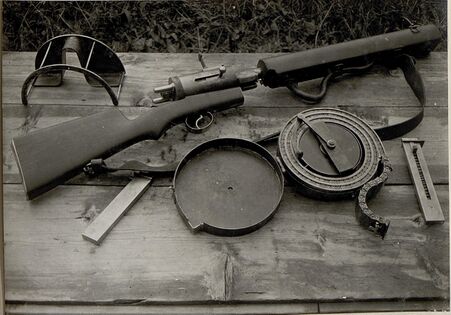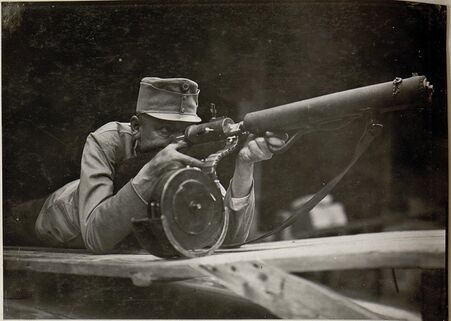| If you have been locked out of your account you can request a password reset here. |
Difference between revisions of "Standschütze Hellriegel 1915"
| Line 2: | Line 2: | ||
[[File:Standschütze Hellriegel 1915 drum.jpg|thumb|right|451px|Standschütze Hellriegel 1915 heavy submachine gun with ~160-round drum - 9x23mm Steyr. This is how the drum was actually employed.]] | [[File:Standschütze Hellriegel 1915 drum.jpg|thumb|right|451px|Standschütze Hellriegel 1915 heavy submachine gun with ~160-round drum - 9x23mm Steyr. This is how the drum was actually employed.]] | ||
| − | The '''Standschütze Hellriegel 1915''' is an Austro-Hungarian crew-served "heavy" submachine gun produced during World War 1. While a submachine gun by definition of an automatic pistol-caliber weapon, the term "submachine gun" was first coined in 1921 to advertise the [[Thompson Submachine Gun]]. At the time, the Hellriegel was referred to as a machine gun (''Maschinengewehr''). It could feed from standard box magazines, or from a large drum magazine which was not actually connected to the weapon and instead fed the cartridges through a flexible chute. The unusual appearance of this drum magazine led to some assumptions that it was belt fed, however this is not the case with the rounds being unconnected from one another and are propelled along the drum and feed chute by a spring in a similar manner to the ''Trommelmagazin'' snail drum used by the Luger pistol. The drum magazine can supposedly hold up to one hundred and sixty rounds while the box mag is limited to twenty or so. As of current knowledge, there was only ever one example of the Hellriegel and it did not survive the war. It is assumed to have been blowback operated with the projections at the rear being a pair of recoil springs, and the large structure over the barrel is thought to have been a leather-wrapped water or oil jacket for cooling. | + | The '''Standschütze Hellriegel 1915''' is an Austro-Hungarian crew-served "heavy" submachine gun produced during World War 1. While a submachine gun by definition of an automatic pistol-caliber weapon (and "heavy" for being crew-served), the term "submachine gun" was first coined in 1921 to advertise the [[Thompson Submachine Gun]]. At the time, the Hellriegel was referred to as a machine gun (''Maschinengewehr''). It could feed from standard box magazines, or from a large drum magazine which was not actually connected to the weapon and instead fed the cartridges through a flexible chute. The unusual appearance of this drum magazine led to some assumptions that it was belt fed, however this is not the case with the rounds being unconnected from one another and are propelled along the drum and feed chute by a spring in a similar manner to the ''Trommelmagazin'' snail drum used by the Luger pistol. The drum magazine can supposedly hold up to one hundred and sixty rounds while the box mag is limited to twenty or so. As of current knowledge, there was only ever one example of the Hellriegel and it did not survive the war. It is assumed to have been blowback operated with the projections at the rear being a pair of recoil springs, and the large structure over the barrel is thought to have been a leather-wrapped water or oil jacket for cooling. |
The only visual evidence the gun ever existed is three pictures of a prototype being tested, found in an Austrian military archive captioned ''Maschinengewehr des Standschützen Hellriegel'' and dated 10.1915. All three pictures were taken from the right side of the gun, so what the left side looked like is a complete mystery. Not even its name can be fully explained: ''Standschütze'' refers to the Austro-Hungarian reserve forces during World War 1, and Hellriegel is an Austrian surname. This is thought to mean that it was either designed for the reserve forces by someone named Hellriegel, or designed by someone named Hellriegel who was a member of the reserve forces. Its ammunition capacity, operating method and which 9mm round it actually fired are conjecture based on analysis of the photographs and historical context. The provision for a drum but not a bipod means it is also not clear what exactly the weapon was intended to be used for. | The only visual evidence the gun ever existed is three pictures of a prototype being tested, found in an Austrian military archive captioned ''Maschinengewehr des Standschützen Hellriegel'' and dated 10.1915. All three pictures were taken from the right side of the gun, so what the left side looked like is a complete mystery. Not even its name can be fully explained: ''Standschütze'' refers to the Austro-Hungarian reserve forces during World War 1, and Hellriegel is an Austrian surname. This is thought to mean that it was either designed for the reserve forces by someone named Hellriegel, or designed by someone named Hellriegel who was a member of the reserve forces. Its ammunition capacity, operating method and which 9mm round it actually fired are conjecture based on analysis of the photographs and historical context. The provision for a drum but not a bipod means it is also not clear what exactly the weapon was intended to be used for. | ||
| − | |||
==Specifications== | ==Specifications== | ||
Revision as of 03:36, 4 June 2018
The Standschütze Hellriegel 1915 is an Austro-Hungarian crew-served "heavy" submachine gun produced during World War 1. While a submachine gun by definition of an automatic pistol-caliber weapon (and "heavy" for being crew-served), the term "submachine gun" was first coined in 1921 to advertise the Thompson Submachine Gun. At the time, the Hellriegel was referred to as a machine gun (Maschinengewehr). It could feed from standard box magazines, or from a large drum magazine which was not actually connected to the weapon and instead fed the cartridges through a flexible chute. The unusual appearance of this drum magazine led to some assumptions that it was belt fed, however this is not the case with the rounds being unconnected from one another and are propelled along the drum and feed chute by a spring in a similar manner to the Trommelmagazin snail drum used by the Luger pistol. The drum magazine can supposedly hold up to one hundred and sixty rounds while the box mag is limited to twenty or so. As of current knowledge, there was only ever one example of the Hellriegel and it did not survive the war. It is assumed to have been blowback operated with the projections at the rear being a pair of recoil springs, and the large structure over the barrel is thought to have been a leather-wrapped water or oil jacket for cooling.
The only visual evidence the gun ever existed is three pictures of a prototype being tested, found in an Austrian military archive captioned Maschinengewehr des Standschützen Hellriegel and dated 10.1915. All three pictures were taken from the right side of the gun, so what the left side looked like is a complete mystery. Not even its name can be fully explained: Standschütze refers to the Austro-Hungarian reserve forces during World War 1, and Hellriegel is an Austrian surname. This is thought to mean that it was either designed for the reserve forces by someone named Hellriegel, or designed by someone named Hellriegel who was a member of the reserve forces. Its ammunition capacity, operating method and which 9mm round it actually fired are conjecture based on analysis of the photographs and historical context. The provision for a drum but not a bipod means it is also not clear what exactly the weapon was intended to be used for.
Specifications
- Caliber: 9mm, most likely 9x23mm Steyr though 9x19mm Parabellum has also been speculated
The Standschütze Hellriegel 1915 and variants can be seen in the following films, television series, video games, and anime used by the following actors:
Video Games
| Game Title | Appears as | Mods | Notation | Release Date |
|---|---|---|---|---|
| Battlefield 1 | Hellriegel 1915 | Shown with fictional side-mounted drum | 2016 |

